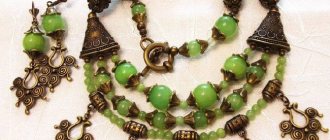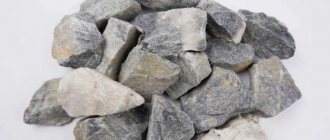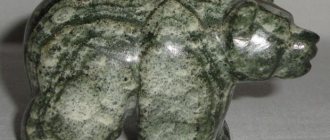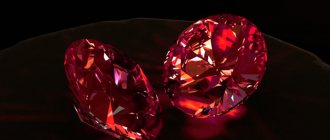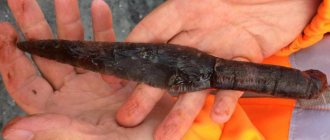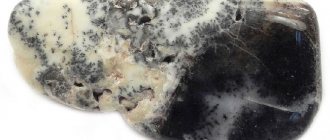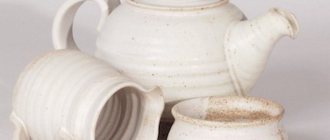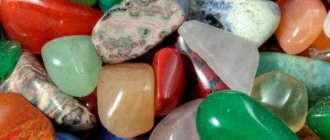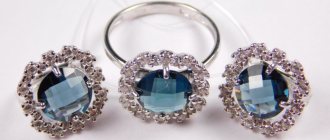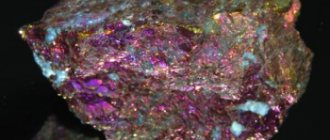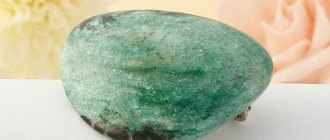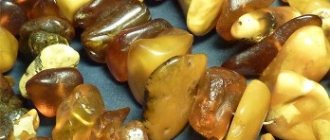The semi-precious stone is buranite, the color of which can change depending on temperature changes. The most popular color in the jewelry market is green because this is the shade that is in demand among people. The crystal also does not have any magical or healing qualities, since it was produced artificially.
Buranite is very similar to natural amber, you should learn to distinguish it. In addition, you need to be able to combine minerals with metals for jewelry making.
Story
Natural green amber is one of the most beautiful and exotic in its family. However, its share in the total volume of raw material production does not exceed two percent, which makes the mineral inaccessible to most people.
Scientists and technologists solved the problem by creating an artificial analogue.
Russian specialists started doing this half a century ago and identified the Kaliningrad Amber Factory as the “deposit”:
- The first product was burnite. It was obtained by fusing amber chips, polyester resins and dyes.
- After a couple of decades, an improved version appeared. It went down in history as Buranite (the name almost copies Bernite).
- The consumer properties of buranite exceed those of the “parent”. And there are no shortcomings that indicate resin origin.
- It also contains amber chips (up to 5%), polyester resins and dyes. However, the exact recipe and subtleties of technology are a trade secret.
It is only known that micro-explosion technology is used to create the fractures inherent in natural amber.
At first, Buranite was positioned as artificial amber, but it sold poorly. Therefore, marketers came up with an attractive name.
Cowrie resin
Kauri gum (or cowrie resin) is a substance related to copal, and had every chance of joining the triumphant procession of amber through the jewelry counters of the planet. This resin is produced by kauri trees, a type of coniferous araucaria. The history of cowries is venerable: these plants gave shelter to dinosaurs...
In case of damage to the root system, kauri trees produce a lot of oleoresin! A strong wind, swaying tall trunks, sometimes tears the roots - and then an impressive (up to half a ton!) deposit of resin forms in the ground under the tree.
However, the accumulation of resin wealth did not work out... The chemical composition of cowrie resin is only in general terms similar to the composition of amber - the same degree of similarity is observed with physical properties. Therefore, copal kauri gum is mostly used for the production of high-quality varnishes, and only in small quantities is it “modernized” by craftsmen for fake amber.
Kauri gum is usually classified as copal, despite the fact that the external resemblance of kauri gum to natural amber can be strikingly strong. In one of the museums in Auckland (New Zealand) there is an entire hall dedicated to cowrie gum. According to ordinary visitors, huge blocks of resin look exactly like amber!
What does the stone look like?
Description of a typical Buranite is akin to a gemstone:
- Transparent
- It's quite shiny.
- There are no impurities or inclusions.
Depending on the color, Buranite looks like an emerald, ruby or sapphire.
To give it a resemblance to elite green or blue natural amber, the mineral is provided with “cracks”, intricate patterns in the thickness, and slightly cloudy.
Aragonite
The delicate mineral aragonite can be purple, white or light green. There are samples of blue and even black colors. The stone received its name in honor of Spanish Aragon, where it was found. Lithotherapists use an unusual mineral most often to treat the reproductive system. It is believed that aragonite can cure impotence or frigidity, and increase the sexual activity of its owner. The stone is also used to combat sexually transmitted or inflammatory diseases of the genital organs in men and women. In addition to these functions, aragonite copes with insomnia, helps relieve fatigue, tension, and eliminates the consequences of long hard work or stress.
A gentle pebble brings comfort and warmth to your home.
He tries to instill an atmosphere of friendliness and comfort. Aragonite can rightfully be considered a family stone . In case of any aggravation of family relations, it is recommended to have something made from this mineral in the house. It will not only eliminate an unexpected conflict, but will also allow you to remember all the long-forgotten warm and strong feelings. The stone helps in raising children, and also becomes a conciliatory thing for the mother-in-law and daughter-in-law. Astrologers talk about the zodiacal versatility of this mineral. The only “but”: only married girls or married men can wear aragonite.
Where is it used?
The cheap, easy-to-process mineral has found application among jewelers and decorators:
- Jewelers create sets of jewelry with inserts of any size and configuration. Basically these are earrings plus a ring plus a pendant. White or grayish metal is suitable as a frame: nickel silver, cupronickel, silver, jewelry alloy.
- Decorators cut small plastic, inlay household items, furniture, and panels.
Jewelry made from buranite
Collectors use buranite as an exhibit of the department of technological achievements.
Polyester
Polyester, a completely artificial substance, and natural amber, the ancient fossilized resin of coniferous trees, are chemical relatives. Both compounds are polyesters. Polyester alone is produced and consumed in thousands of tons (mostly in the form of fabrics), and amber is mined from sediments and is used mainly for admiration. The chemical similarity of substances often becomes the basis for the structural similarity of samples. It should be noted that polyester and amber can be so similar to each other in appearance that we have to talk not about likeness, but about copying. Fortunately for amber buyers, polyester fakes have not (yet) become widespread. One of the reasons is the absolute dominance of polyester on the market, which is only suitable for creating fibrous materials. Special reagents and high-pressure thermal units are required to convert industrial polyester into pseudo-amber. True, the similarity between real amber and polyester “amber” is limited to the optical properties of the materials. Polyester is lighter and warmer to the touch, and when heated (even in the hand) it emits a plastic smell. Yes, and swindlers and counterfeiters work today in a rather rude manner. The defects of natural stone they imitate in polyester cabochons and beads look deliberate, too artificial and catchy. However, nothing prevents artisans from hiring a talented designer and achieving higher professionalism...
How to distinguish
Not all manufacturers indicate the origin of the product, so for connoisseurs of natural stones the relevant question is how to distinguish imitation from amber.
The properties of buranite help to do this:
- It is very bright and shiny. Amber does not look like this even after polishing.
- When rubbed against wool, it does not become electrified and does not attract hair, threads, or paper.
- It is heavier and difficult to scratch.
Imitation can be distinguished by color. Buranite is homogeneously saturated. And the Baltic mineral is grayish-green. The raw materials mined in the Dominican Republic are blue-green. Lush green natural stones are not offered for sale.
Faturan
Confusion arose with faturan, an old and well-deserved material. The fact is that faturan is old and has many faces...
The invention of faturan occurred in the ΧVΙΙΙ century. Eastern craftsmen took waste from jewelry processing of amber (dust and shavings), resin from local plants; the products were mixed, heated, pressed - and the result was faturan. The skill of the artisans turned out to be so high that faturan beads instantly became money, equivalent to coins in circulation. Matte shiny honey-red beads still make an indelible impression today. However, the three-hundred-year-old recipe has been lost, and it is not possible to restore authentic production. Everyone thought so, except for Dr. Thrawn, a Hamburg entrepreneur at the beginning of the last century. Seeing the high commercial potential in bakelite, Thrawn decided to slightly modify the technological process and pass off minimally modified (simply tinted) bakelite as faturan, beloved by the East. The scam was a success. Until the early 40s of the 19th century, Thrawn's company was supplying new-made faturan to the Middle East. Transit was carried out through Turkey. The product penetrated into all countries of Western Asia. Inspired by Thrawn's success, modern scammers continue their criminal experiments and try to imitate both natural amber and ancient faturan by mixing who knows what synthetic ingredients. At the same time, everyone unanimously calls their crafts faturan. Neither Dr. Thrawn's bakelite nor the crafts of our day have anything to do with the ancient faturan that has become precious. And faturan itself (even the most real one) is very indirectly related to amber...
How to care
Buranite is stronger than amber and easier to care for:
- Store separately from other products.
- Remove dirt with warm water (you can use soft dish gel) and a soft cloth or brush.
- Then wipe dry to avoid water stains.
- Soda, vinegar, strong household chemicals, and abrasives are prohibited.
- Make sure that the frame cleaner does not come into contact with the insert.
Jewelry is removed when going to the sauna, swimming pool, gym, or the beach.
Acrylic
Polymethyl methacrylate has been known for quite some time. This is quite ordinary organic glass, otherwise called plexiglass or simply acrylic. During the Second World War, transparent elements of aircraft cabins were made from plexiglass. Nowadays, bathtubs are made from milky-colored acrylic, and imitation amber is made from transparent plastic tinted the color of honey. You can mistake acrylic “amber” for real only from afar or in a photo. The artificiality of the material is too obvious. The hand-made nature of internal defects and inclusions is too noticeable. Acrylic is deliberately shiny, and the shape of its beads is perfectly standard. However, acrylic products can mislead an uninitiated person. Modern methods of making counterfeits sometimes achieve their goal. Acrylic “amber” - especially in photos and videos - looks not just like real, but like jewelry amber of exemplary quality. There have been cases of falsification of premium jewelry with acrylic. Copying models of famous designers, scammers exactly repeat the shape of gold and silver frames and simulate the expressiveness of an amber cabochon. Such counterfeits are advertised via the Internet and sold by mail. In the videos, amber-like acrylic and “samovar gold” look extremely presentable. The products also look good in kind - for a short time... However, the very first visit to the jeweler makes the situation clear: costume jewelry, even of particularly high quality, does not cost as much as natural amber in a gold frame.
Magical and healing properties
Buranite has no healing effects or magical properties. The reason is clear: amber takes millions of years to form, absorbing the energy of nature. Buranite is created in a couple of hours, the amber crumb is only 5% (sometimes 0%).
For the same reason, astrologers do not attach importance to the mineral.
Artificial origin is not always a minus: jewelry with buranite will suit everyone, regardless of their zodiac sign, lifestyle or character traits.
Color therapists say: magic is created by the color green. It strengthens vision and gives rest to the eyes. A bright stone improves your mood. And this is the key to mental balance and physical health.
Inclusions
From time immemorial, the authenticity of amber was determined, among other things, by the presence of inclusions - biological remains sealed in living deposits millions of years ago. But who in childhood did not have fun drowning flies in candle stearin? Modern scammers continue children's games, and enthusiastically push flies, spiders, and even small reptiles into hardening synthetics.
The difference is sometimes subtle, but in most cases obvious. A spider or mosquito, captured by resin a hundred million years ago, has long lost its flesh and become translucent. Their body has disappeared! All that remained was a bleached (in most cases) chitinous cover, and the exact form of a creature that once lived on Earth. Inclusion in natural amber is 99.9% empty, cavity! Fakes, on the other hand, show resin-filled insects in all their pristine glory. Synthetic polymers often act as preservatives, and therefore the blowfly, “packed” in resin two hundred years ago, looks as if it were alive – and also has a shiny blue-green cover! Artificial inclusions also reveal themselves as unnatural objects. The insect, having stuck to the resin, remains intact. Tweezers and other craft tools are crude and often strip mosquitoes of their wings or legs. However, on the market for geological rarities and amber jewelry there are many fakes that are almost indistinguishable from the genuine stone. Are artificial resins determined by spectrometers? Fraudsters - in light of the current increase in amber prices - are hastily purchasing hardened araucaria resin from the Southern Hemisphere, melting it, and placing not only insects and spiders, but also small reptiles and even exotic mollusks into castings. Classifying fakes as rare inclusions, hired propagandists convince collectors to purchase “amber” before representatives of wealthy museums arrive. “Such exhibits,” the tempters whisper, “are not even in the natural history museums of London and New York!” And the unlucky buyer who signs an order for a multi-thousand-dollar payment has no idea that this is because museums are not interested in forgeries! Amber counterfeiters are expanding their arsenal of criminal techniques and improving their ability to deceive. The latest trend in the market is the passing off of initially inexpensive, but modified and “improved” copals as amber. Amateur chemists are not asleep either. Artificial resins and even composites are increasingly taking on the appearance of amber - a silent witness of time immemorial, the eternal symbol of the Sun, an ancient friend of man and humanity.
Natural amber can be purchased in our store.
